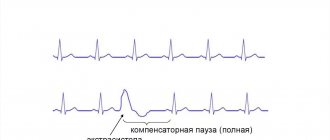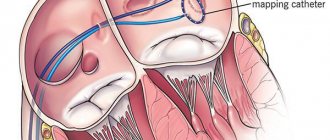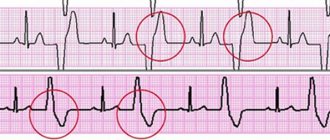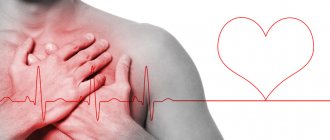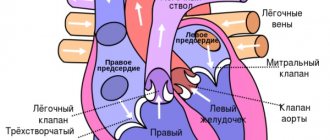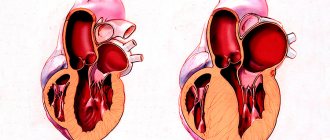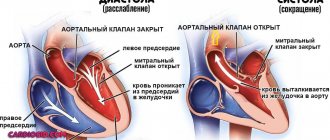Svetlana Shcherbakova
Cardiologist
Higher education:
Cardiologist
Kabardino-Balkarian State University named after. HM. Berbekova, Faculty of Medicine (KBSU) Level of education – Specialist 1994-2000
Additional education:
“Cardiology”
State Educational Institution “Institute for Advanced Training of Physicians” of the Ministry of Health and Social Development of Chuvashia
Contacts
One type of arrhythmia is extrasystole, when an extraordinary contraction occurs between rhythmic beats. In this case, the impulse is generated not by the sinus node (the first pacemaker), but by the conduction bundle of His or Purkinje fibers. Extraordinary contractions of different parts of the heart are detected on daily electrocardiographic monitoring in almost half, and after the age of 50 years - in all patients. In most young people it is functional in nature, does not affect health and does not manifest itself clinically. The situation is different with pathological changes in the heart muscle. There is an international classification of extrasystoles, which allows one to determine the severity of the disease and its prognosis.
Types of extrasystole
1. By localization:
- Sinus.
- Atrial.
- Atrioventricular.
- Ventricular
2. Time of appearance in diastole:
- Rare (up to 5/min).
- Medium (6-15/min).
- Frequent (more than 15/min).
5. By frequency:
- Sporadic (random).
- Allorhythmic – systematic – bigeminy, trigeminy, etc.
6. On carrying out:
- Repeated impulse entry using the re-entry mechanism.
- Blockade of conduction.
- Supernormal conduction.
8. By number of sources:
Sometimes the so-called interpolated ventricular extrasystole - it is characterized by the absence of a compensatory pause, that is, the period after the extrasystole when the heart restores its electrophysiological state.
Lown and its modification according to Ryan has gained great importance .
Classification of extrasystole according to Lown
The creation of the Lown classification of ventricular extrasystole is an important step in the history of arrhythmology. Using the classification in clinical practice, the doctor can adequately assess the severity of the disease in each patient. The fact is that PVC is a common pathology and occurs in more than 50% of people. In some of them, the disease has a benign course and does not threaten their health, but others suffer from a malignant form, and this requires treatment and constant monitoring of the patient. The main function of ventricular extrasystole, Lown classification, is to distinguish malignant from benign pathology.
Ventricular extrasystole gradation according to Laun includes five classes:
1. Monomorphic ventricular extrasystole with a frequency of less than 30 per hour.
2. Monomorphic PVC with a frequency of more than 30 per hour.
3. Polytopic ventricular extrasystole.
4. The fourth class is divided into two subclasses:
- Paired VES.
- 3 or more VES in a row – ventricular tachycardia.
5. VES type R on T. ES is assigned the fifth class when the R wave falls on the first 4/5 of the T wave.
Lown's classification of PVCs has been used by cardiologists, cardiac surgeons and doctors of other specialties for many years. Appeared in 1971 thanks to the work of B. Lown and M. Wolf, the classification, as it seemed then, would become a reliable support for doctors in the diagnosis and treatment of PVCs. And so it happened: until now, several decades later, doctors focus primarily on this classification and its modified version from M. Ryan. Since that time, researchers have not been able to create a more practical and informative gradation of VES.
However, attempts to introduce something new have been made repeatedly. For example, the already mentioned modification from M. Ryan , as well as the classification of extrasystoles by frequency and form from RJ Myerburg .
Features in children
If a child has been diagnosed with supraventricular extrasystole, then you should first of all monitor his lifestyle and follow a daily routine
It is important to explain to your child that if he does not follow all preventive measures, serious complications may arise that will negatively affect his health.
The child's diet should be varied and balanced. Food should be rich in amino acids, vitamins, proteins, fats, carbohydrates and minerals. The diet should include fruits, vegetables, dairy products, fish and meat. You should minimize the consumption of sweets and junk food.
In order to prevent further development of the pathological condition, it is necessary for the child to have rational physical activity and spend as much time as possible in the fresh air. The baby's condition may worsen due to a cold or infectious disease.
Important! If the child’s condition worsens, you should immediately contact a pediatrician or cardiologist. In some cases, hospitalization is required.
Classification of extrasystole according to Ryan
The modification made changes to grades 4A, 4B and 5 of ventricular extrasystole according to Lown. The complete classification looks like this.
1. Ventricular extrasystole grade 1 according to Ryan – monotopic, rare – with a frequency of less than 30 per hour.
2. Ventricular extrasystole grade 2 according to Ryan – monotopic, frequent – with a frequency of more than 30 per hour.
3. Ventricular extrasystole grade 3 according to Ryan – polytopic VES.
4. The fourth class is divided into two subclasses:
- Ventricular extrasystole grade 4a according to Ryan – monomorphic paired VVCs.
- Ventricular extrasystole grade 4b according to Ryan is a paired polytopic extrasystole.
5. Ventricular extrasystole grade 5 according to Ryan – ventricular tachycardia – three or more VVCs in a row.
Ventricular extrasystole - classification according to RJ Myerburg
The Myerburg classification divides ventricular arrhythmias depending on the shape and frequency of PVCs.
Frequency division:
- Rare - less than one ES per hour.
- Infrequent - from one to nine ES per hour.
- Moderate frequency - from 10 to 30 per hour.
- Frequent ES - from 31 to 60 per hour.
- Very frequent - more than 60 per hour.
Division by shape:
- Single, monotopic.
- Single, polytopic.
- Double.
- Ventricular tachycardia lasting less than 30 seconds.
- Ventricular tachycardia lasting more than 30 seconds.
- RJ Meyerburg published his classification in 1984, 13 years later than B. Lown. It is also actively used, but significantly less than those described above.
Complications
With physiological extrasystole that occurs benignly, without hemodynamic disturbances, complications rarely arise. But if it is malignant, then complications occur quite often. This is precisely why extrasystole is dangerous.
The most common complications of extrasystole are ventricular or atrial fibrillation, paroxysmal tachycardia. These complications can threaten the patient's life and require urgent, emergency care.
In severe forms of extrasystole, the heart rate can exceed 160 beats per minute, which can result in the development of arrhythmic cardiogenic shock and, as a consequence, pulmonary edema and cardiac arrest.
Extrasystole can be accompanied not only by tachycardia, but also by bradycardia. In this case, the heart rate does not increase, but, on the contrary, decreases (there can be up to 30 contractions per minute or less). This is no less dangerous for the patient’s life, since with bradycardia conduction is impaired and there is a high risk of heart block. Source "sosudinfo.ru"
Complications mainly occur with malignant variants with frequent attacks. These include ventricular tachycardia with circulatory failure, ventricular flutter/fibrillation, leading to complete cardiac arrest.
In other cases, the prognosis is often favorable. If all treatment recommendations are followed, even in the presence of concomitant diseases, mortality from this disease is significantly reduced. Source "webmedinfo.ru" The prognosis of VES depends entirely on the severity of the impulse disturbance and the degree of ventricular dysfunction.
With pronounced pathological changes in the myocardium, extrasystoles can cause atrial and ventricular fibrillation, persistent tachycardia, which in the future can lead to death.
If an extraordinary blow during relaxation of the ventricles coincides with contraction of the atria, then the blood, without emptying the upper compartments, flows back into the lower chambers of the heart. This feature provokes the development of thrombosis.
This condition is dangerous because a clot consisting of blood cells, when it enters the bloodstream, becomes the cause of thromboembolism. When the lumen of blood vessels is blocked, depending on the location of the lesion, the development of such dangerous diseases as stroke (damage to the blood vessels of the brain), heart attack (damage to the heart) and ischemia (impaired blood supply to internal organs and limbs) is possible.
To prevent complications, it is important to consult a specialist (cardiologist) in time. Properly prescribed treatment and following all recommendations are the key to a quick recovery. Source "zdorovko.info"
Classification of extrasystole according to JT Bigger
The diagnosis of VES in itself does not say anything about the patient’s condition. Much more important is information about concomitant pathologies and organic changes in the heart. To assess the likelihood of complications, JT Bigger proposed his own version of the classification, on the basis of which one can draw a conclusion about the malignancy of the course.
Read also: Autologous stem cell transplantation
In the JT Bigger classification, PVCs are assessed according to a number of criteria:
- clinical manifestations;
- VES frequency;
- the presence of a scar or signs of hypertrophy;
- the presence of persistent (lasting more than 30 seconds) or unstable (less than 30 seconds) tachycardia;
- left ventricular ejection fraction;
- structural changes in the heart;
- influence on hemodynamics.
A PVC with pronounced clinical manifestations (palpitations, fainting), the presence of scars, hypertrophy or other structural lesions, a significantly reduced left ventricular ejection fraction (less than 30%), a high frequency of PVC, the presence of persistent or non-sustained ventricular tachycardia, a minor or pronounced effect is considered malignant. on hemodynamics.
Potentially malignant PVC : mildly symptomatic, occurs against the background of scars, hypertrophy or other structural changes, accompanied by a slightly reduced left ventricular ejection fraction (30-55%). The frequency of PVCs can be high or moderate, ventricular tachycardia is either unstable or absent, hemodynamics suffer slightly.
Benign PVC : not clinically manifested, there are no structural pathologies in the heart, the ejection fraction is preserved (more than 55%), the frequency of ES is low, ventricular tachycardia is not recorded, hemodynamics do not suffer.
The extrasystole criteria of the JT Bigger classification give an idea of the risk of developing sudden death - the most dangerous complication of ventricular tachycardia. Thus, with a benign course, the risk of sudden death is considered very low, with a potentially malignant course - low or moderate, and the malignant course of VES is accompanied by a high risk of developing sudden death .
Sudden death refers to the transition of PVCs to ventricular tachycardia and then to atrial fibrillation. With the development of atrial fibrillation, a person goes into a state of clinical death. If resuscitation measures are not started within a few minutes (best defibrillation with an automatic defibrillator), clinical death will be replaced by biological death and it will become impossible to bring the person back to life.
Symptoms
Single ventricular premature contractions are recorded in half of healthy young people during monitoring for 24 hours (Holter ECG monitoring). They do not affect your well-being. Symptoms of ventricular extrasystole appear when premature contractions begin to have a noticeable effect on the normal rhythm of the heart.
Ventricular extrasystole without concomitant heart diseases is very poorly tolerated by the patient. This condition usually develops against the background of bradycardia (slow pulse) and is characterized by the following clinical symptoms:
- a feeling of cardiac arrest, followed by a whole series of beats;
- from time to time, separate strong blows are felt in the chest;
- extrasystole may also occur after eating;
- a feeling of arrhythmia occurs in a calm position (during rest, sleep or after an emotional outburst);
- During physical activity, the disturbance practically does not appear.
Ventricular extrasystoles against the background of organic heart diseases, as a rule, are multiple in nature, but for the patient they are asymptomatic. They develop with physical activity and go away while lying down. Typically, this type of arrhythmia develops against the background of tachycardia.
Many women during pregnancy experience tachycardia and pain in the left side of the chest. The development of PVCs in an expectant mother is not uncommon. This is explained by the fact that the circulatory system and the heart have a double burden. In addition, one should take into account the physiological changes in hormonal levels, which affect the rhythm of impulses. Such extrasystole is not malignant and can be easily treated after childbirth.
General information
The factors that caused the development of the disease can be of physiological and pathological origin. An increase in the tone of the sympathetic-adrenal system leads to an increase in the occurrence of extrasystoles. Physiological factors influencing this tone include the consumption of coffee, tea, alcohol, stress and nicotine addiction. There are a number of diseases that lead to the formation of extrasystole:
- cardiac ischemia;
- myocarditis;
- cardiomyopathy;
- heart failure;
- pericarditis;
- hypertonic disease;
- osteochondrosis of the cervical spine;
- prolapse of the mitral valve leaflets;
- cardiopsychoneurosis.
There is a certain connection between the patient’s age, time of day and the frequency of extrasystoles. Thus, more often the ventricular type is present in people over 45 years of age. Dependence on circadian biorhythms is manifested in the registration of extraordinary heart contractions, more in the morning hours.
Ventricular extrasystole threatens the patient’s life. Its formation increases the risk of sudden cardiac arrest or ventricular fibrillation.
Causes
The main reason for the development of left and right ventricular extrasystole is heart disease, but heavy physical activity and stressful situations can also cause this disease.
Cardiac causes include the following types of factors:
- Heart failure. Pathologies in the heart tissues lead to insufficient blood circulation. Because of this, oxygen starvation of organs and tissues and other abnormalities in metabolism are detected.
- Coronary heart disease (CHD). This disease is a consequence of impaired coronary circulation. It may manifest itself as an attack of myocardial infarction or periodic attacks of angina.
- Cardiomyopathy. Pathologies of the myocardium, which lead to a lack of blood flow, extraordinary contractions and enlargement of the heart.
- Heart disease. It may be congenital or acquired. The essence lies in physiological deviations in the abduction.
- Myocarditis. The occurrence of inflammatory processes can cause arrhythmia, excite and contract the myocardium.
Editor's note: What is Prinzmetal's angina?
Pathology can also develop while taking medications, an increased dosage of which leads to abnormalities in cardiac activity:
- Diuretics. Diuretics can reduce the amount of potassium in the body, which is necessary for the formation of heart impulses.
- Glycosides. Used to increase myocardial strength and reduce rhythm, but may have side effects such as arrhythmia or ventricular fibrillation.
There are also non-cardiac causes of the development of ventricular extrasystole.
- Diabetes. During the course of a disease associated with a violation of the regulation of the balance of carbohydrates in the body, damaged nerve fibers arise, which also affect the functioning of the heart, causing rhythm disturbances.
- Thyrotoxicosis.
- Diseases of the adrenal glands.
If ventricular extrasystole is caused by non-cardiac diseases, then it is not organic, but functional. At the same time, by eliminating the negative factor, you can bring the heart rhythm back to normal.
Here are possible functional factors:
- Disturbed electrolyte balance. As already noted, the amount of potassium in the body may decrease when urination changes, and the balance of other electrolytes - calcium and sodium - may also be disrupted after surgery on the liver or small intestine.
- Bad habits. Excessive levels of alcohol or drugs in the body lead to tachycardia. This is caused by a metabolic disorder, which results in poor oxygen supply to the myocardium.
- Stress. Due to panic and stressful situations, a disorder of the autonomic nervous system can develop, and this also affects cardiac activity, causing surges in blood pressure.
Classifications
There are many classifications of ventricular extrasystoles. Each of them is based on some criterion. Having determined whether the pathology belongs to one type or another, the doctor will determine the level of its danger and the method of treatment.
What subgroups are ventricular arrhythmias with extraordinary systoles usually divided into:
- according to the form of rhythm disturbance (mono-, polymorphic, group);
- by the number of sources (mono-, polytopic);
- depending on the frequency of occurrence (rare, infrequent, moderately rare, frequent, very frequent);
- by stability (stable, unstable);
- from the time of appearance (early, late, interpolated);
- according to the pattern of abbreviations (disordered, ordered);
- classification of ventricular extrasystoles according to Lown and Bigger.
Ordered ventricular extrasystoles form a special pattern of development, which determines their name. Bigemeny is an extraordinary contraction of the ventricles, recorded every second normal cardiac cycle, trigemeny - every third, quadrigymeny - every fourth.
Signs on ECG
All NVT have common signs on the cardiogram:
increased heart rate (HR) - from 100 to 250 per minute;
Of course, each type of arrhythmia has its own individual characteristics on film. This happens because the rhythm disorder is based on inadequate electrical activity of the heart and it is different in each case. It is worth mentioning the following features of cardiograms for NVT:
- Before a paroxysm of sinoatrial reciprocal tachycardia, an atrial extrasystole is necessarily present.
- The atrial type is characterized by a change in the shape of the P wave (decreased amplitude, deformation, negativity). It is possible to develop first degree AV block, which appears on film as a prolongation of the PQ interval.
- In SVC syndrome, three specific signs are identified: the presence of a delta wave, shortening of the PQ interval, widening and deformation of the QRS complex.
- Atrial fibrillation and flutter. P waves are completely absent. Instead, there are frequent large F waves (with flutter) or small random f waves.
Sometimes it happens that supraventricular tachycardia is not visible on the ECG, this especially often happens in the paroxysmal form. Therefore, I almost always prescribe Holter (24-hour) ECG monitoring to my patients.
To identify rare SVTs that have additional impulse pathways, a special intracardiac electrophysiological study is performed. It is of great importance, since based on the results of this test the need for surgical treatment is determined.
Gradation of ventricular extrasystoles according to Laun-Wolf
In the medical community, the most common classification of ventricular extrasystole according to Lown.
Its last modification was in 1975, but it still has not lost its relevance and contains the following classes:
- 0 (no arrhythmia);
- 1 (extrasystoles less than 30/hour, from one source and one form);
- 2 (one source and form, 30 or more extrasystoles per hour);
- 3 (multifocal extrasystoles);
- 4a (paired extrasystoles from one focus);
- 4b (polymorphic extrasystoles accompanied by other arrhythmias - ventricular fibrillation/flutter, tachycardia paroxysm);
- 5 (early extrasystoles “type R on T”).
Read also: Collapse heart disease
The mechanism of development of extrasystoles may differ. There are two main ones - reciprocal and automatic. Reciprocal arrhythmias arise when a vicious circle of intraventricular excitation is formed, the so-called “re-entry” mechanism. Its essence lies in the disruption of the passage of a normal signal, which is associated with the presence of at least two paths for the impulse. In this case, the signal for one of them is delayed, which causes the formation of an extraordinary contraction. This mechanism plays a role in the formation of such arrhythmias as paroxysm of ventricular tachycardia and extrasystoles, Wolff-Parkinson-White syndrome, atrial/ventricular fibrillation. An ectopic focus of excitation can occur with increased automatism of the pacemaker cells of the heart. Arrhythmias with such a development mechanism are called automatic.
Prevention of the disease
The following are usually offered as preventative recommendations:
- maintaining a more active and mobile lifestyle;
- giving up bad habits, including smoking, excessive consumption of alcohol and strong coffee;
- regular medical examinations.
Detection of a disease can occur even during a routine preventive examination; for this reason, a health check in a medical institution is a mandatory event for everyone.
Classification of extrasystoles according to Bigger
Bigger's classification provides for the formation of groups of patients according to the degree of increase in the risk of complications.
It includes the following course of extrasystole:
- malignant;
- potentially malignant;
- benign.
With benign extrasystoles, the risk of complications is extremely low. Moreover, such patients have no signs of pathology of the cardiovascular system in the anamnesis and during examination (normal left ventricular ejection fraction, no hypertrophy or cicatricial changes in the myocardium). The frequency of ventricular extrasystoles does not exceed 10 per hour and there is no clinical picture of paroxysmal ventricular tachycardia.
A potentially malignant disease is characterized by a moderate or low risk of sudden death. The examination reveals structural changes in the heart in the compensation stage. Ultrasound of the heart reveals a decrease in LV ejection fraction (30-55%) and the presence of scar or myocardial hypertrophy. Patients complain of a feeling of interruptions in the work of the heart, accompanied by short-term episodes of ventricular tachycardia (up to 30 seconds).
Malignant extrasystoles are those whose manifestation causes a disturbance in the general well-being of the patient (palpitations, fainting, signs of cardiac arrest). Patients exhibit a critical decrease in ejection fraction - less than 30%. Persistent ventricular tachycardia is also noted.
The most dangerous ventricular ecstasystoles include 3 gradations in the Lown classification - 4a, 4b and 5 classes.
general information
Extrasystole means a disturbance in the rhythm of the heart muscle. For various reasons, it may contract prematurely. To determine pathological processes, an electrocardiogram is required. The graph will display an accelerated or premature extrasystolic complex.
It can be parasystolic and extrasystolic
It is important to promptly track these changes to prevent negative consequences and complications. Extrasystole and parasystole are responsible for the work of the main muscle in the body
When their functioning is disrupted, the treatment in both cases is the same.
Extrasystole often occurs in the ventricles of the heart. Pathological processes can occur in the supraventricular region, in the atrium, and atrioventricular muscle.
Clinical manifestations
In most patients, in the absence of damage to the cardiovascular and nervous systems, extrasystole occurs hidden. There are no specific complaints inherent to the disease. Its pronounced clinical picture is usually represented by the following symptoms:
- weakness;
- irritability
- dizziness/headaches;
- feeling of discomfort in the chest (pain, tingling, heaviness);
- heart sinking feeling
- a push in the chest with frequent extrasystoles;
- arrhythmic pulse;
- feeling of pulsation in the veins of the neck;
- dyspnea.
The presence of concomitant cardiac pathology aggravates the course of the disease.
Ventricular asystole
Ventricular asystole is cessation of electrical and mechanical activity of the ventricles, usually of the entire heart, cardiac arrest. Ventricular asystole leads to cessation of blood circulation and clinical death.
Etiology and pathogenesis. Ventricular asystole is usually caused by severe cardiac
- acute (myocardial infarction, pulmonary embolism) or chronic (ischemic disease
heart disease, hypertension, heart defects, myocarditis, myocardial dystrophy, myocardiopathy, heart surgery), the effects of myocardial depressing antiarrhythmic drugs, excessive vagotonia, reflex effects, electric shock, electric pulse treatment.
In the origin of cardiac
Hypoxia and hypercapnia are of greatest importance. At the same time, the pH of the blood decreases, which causes conduction disturbances up to cardiac arrest. An increase in the tone of the vagus nerve, leading to asystole when the blood pH decreases, also plays a certain role.
Electrolytes are important. Thus, rapid infusion of potassium solutions can lead to asystole.
Along with this, hypokalemia can cause cardiac arrest (more often with intoxication with cardiac glycosides). At the same time, in response to the action of cardiac glycosides, myocardial excitability sharply increases.
Clinic. Ventricular asystole leads to a sudden disappearance of the pulse (not only in the radial artery, but also in the carotid artery), heart sounds, and blood pressure. After a few seconds, the patient loses consciousness, turns pale, and stops breathing. 45 s after the cessation of cerebral circulation, the pupils begin to dilate, reaching a maximum after 1 min 45 s, convulsions, involuntary urination and defecation appear. The electrocardiogram shows a straight line (no electrical activity of the heart).
Diagnostics. It should be borne in mind that circulatory arrest and clinical death are more often associated with ventricular fibrillation than with asystole. And the latter is often preceded by ventricular fibrillation. The clinical picture is the same in both cases. Differentiation can be made only by observing the electrocardiogram on the monitor or by recording the electrocardiogram curve. With asystole, there is no electrical activity of the heart, and therefore a straight line is recorded; with ventricular fibrillation, large or small random biphasic waves are recorded.
Treatment: external cardiac
and artificial respiration - should be started immediately after the first clinical signs of ventricular asystole appear. If the patient was not under electrocardiographic monitoring and there is no certainty that this is not ventricular fibrillation, ventricular defibrillation should be performed. If asystole is diagnosed, electrical stimulation of the heart is necessary as soon as possible. If cardiac stimulation is not possible, 0.5-1 ml of 0.1% adrenaline solution and 5 ml of 10% calcium chloride solution are injected intracardially, norepinephrine, sodium bicarbonate (150-200 ml of 5% solution) are administered intravenously.
The prognosis for ventricular asystole is usually unfavorable. Mortality in certain diseases (for example, heart attack
myocardium) reaches 90-95%.
Prevention of ventricular asystole consists of timely and active treatment
diseases that cause it. The risk of early relapse can be reduced by intramuscular administration of ornid (bretylium tosylate) 0.3-0.6 g every 6 hours. If long-term use for prophylactic purposes is necessary, beta-blockers are the drugs of choice: anaprilin (Inderal, Obzidan) 0.02 -0.04 g, oxprenolol 0.04-0.08 g, cordan 0.05 g 3-4 times a day.
All information on the site, including recipes, is posted and distributed “as is” and does not encourage you to take any action. The site administration is not responsible for the correct description of medications and recipes; one incorrectly defined symptom can lead to an error. We strongly recommend that you consult your doctor.
Diagnostics
Making a diagnosis is based on the results of collecting complaints, the history of the patient’s development and life, data from a comprehensive examination and additional studies. Assessing the patient’s condition, the doctor pays attention to increased pulsation of the neck veins, changes in the pulse wave and auscultatory pattern of heart sounds. A standard set of laboratory tests is prescribed (general blood and urine analysis, blood glucose and biochemical blood test), as well as an analysis of thyroid and pituitary hormones.
To obtain an accurate diagnosis, the mandatory criterion is the result of an ECG and daily Holter monitoring. Using these methods, it is possible to accurately determine the source of the pathological focus, the frequency of extrasystoles, the number and relationship with the load. Echo-CG is performed to identify the left ventricular ejection fraction and the presence/absence of structural changes in the heart. If it is difficult to diagnose the disease, MRI, CT, and angiography may be prescribed.
If there are no patient complaints, with a benign course of extrasystole, only monitoring the state of the cardiovascular system is indicated. Such patients are recommended to undergo examination 2 times a year with mandatory ECG registration. The tactics of patient management depend on the number of extrasystoles per day, the course of the disease, and the presence of concomitant pathology. The dosage of drugs is selected individually by the attending physician.
Antiarrhythmic drugs are divided into 5 classes:
- 1a – Na + channel blockers (“Procainamide”, “Disopyramide”);
- 1c – activators of K + channels (“Difenin”, “Lidocaine”);
- 1c – Na + channel blockers (“Flecainide”, “Propafenone”);
- 2 – beta-blockers (“Metaprolol”, “Propranolol”);
- 3 – K + channel blockers (“Amiodarone”, “Ibutilide”);
- 4 – Ca 2+ channel blockers (“Diltiazem”, “Verapamil”);
- 5 – Other drugs with antiarrhythmic effects (cardiac glycosides, calcium, magnesium preparations).
For ventricular extrasystole, class 2 drugs are widely used. They help reduce symptoms of arrhythmia and also have a positive effect on the quality of life of patients.
Scientific studies have proven that beta-adrenergic blockers improve the prognosis regarding the risk of cardiac death in patients with cardiovascular pathology.
Read also: Signs of extrasystole
Persistent ventricular extrasystole according to Lown, which is not amenable to drug treatment, requires surgical intervention. For the success of the operation, it is necessary to accurately know the source of pathological activity. When it is determined, patients undergo implantation of cardioverter-defibrillators or radiofrequency catheter ablation.
How to treat ventricular asystole
Treatment of asystole or cardiac arrest occurs in three stages:
- emergency help;
- emergency assistance with medications;
- surgical treatment.
First emergency aid in case of cardiac arrest must be provided immediately, since it determines whether the person will survive. First you need to perform an indirect cardiac massage, which is performed by punching the chest area. If special equipment is available, it is necessary to perform defibrillation, connect the victim to a ventilator and provide him with pure 100% oxygen using a mask or endotracheal tube.
If the first emergency aid does not bring the person back to his senses, special medications must be used. These drugs include adrenergic agonists, antiarrhythmic drugs, and M-blockers. Such drugs will help improve the conduction of impulses throughout the organ, thereby increasing the number of heart contractions and restoring normal heart rhythm.
As for surgical treatment, it consists of pericardiocentesis and puncture of the pleural cavity.
Principle of classification
There are many factors that characterize a particular disease. As for extrasystoles, the following signs are distinguished:
- number of ectopic areas (mono-, polytopic);
- form of arrhythmia (mono-, polymorphic);
- frequency of occurrence (rare, moderately frequent, frequent);
- localization (right, left ventricular);
- pattern of abbreviations (ordered, unordered);
- frequency (spontaneous, regular).
In accordance with these parameters, many options were proposed: according to Bigger, Mayerburg. However, the Laun-Wolff classification turned out to be the most practical and popular. Ventricular extrasystole according to Laun is determined using so-called gradations, each of which is assigned one number :
- 0 – no arrhythmias during the last 24 hours of observation;
- I – no more than 30 arrhythmias are observed during an hour of monitoring, monotopic and monomorphic;
- II – more than 30 per hour of the same type;
- III – polymorphic extrasystoles appear;
- IVa – paired monomorphic;
- IVb – paired polymorphic;
- V – characterized by the presence of ventricular tachycardia (extrasystoles that occur more than 3 times in a row).
The use of gradations for the treatment of extrasystole
The presence of the degree of arrhythmia in the formulation of the diagnosis is very important. The treatment tactics chosen by the doctor will depend on this.
Thus, the presence of extrasystoles of the first gradation in a patient indicates the functional nature of the resulting abnormal contractions. About 60-70% of people have a similar phenomenon, and this is considered the absolute norm. The only thing required is to periodically check the ECG. However, if you have any symptoms of cardiovascular pathologies, you should undergo additional examination, as this may be one of the debuts of the disease.
In the presence of the second gradation without signs of hemodynamic impairment, non-drug treatment is indicated - auto-training, psychotherapy, avoidance of risk factors. If there are accompanying symptoms or the appearance of polymorphic foci is noticed (third gradation), an appropriate course of antiarrhythmic drugs is required.
Finally, grades four and five, as well as grade three refractory to conservative therapy, especially in the presence of hemodynamic disturbances, require surgical treatment. In this case, surgical interventions such as catheter radiofrequency ablation or pacemaker implantation may be indicated.
This classification is also used to make a forecast. Ventricular extrasystole grade 3-5 according to Lown is considered threatening. These are the so-called malignant arrhythmias. They are characterized by a high risk of sudden death. In this case, the patient should be transferred to the intensive care unit.
The location of the lesions also matters. The prognosis is less favorable in the presence of left ventricular arrhythmias
Traditional methods
If the extrasystole is not life-threatening and is not accompanied by hemodynamic disturbances, you can try to defeat the disease on your own. For example, when taking diuretics, potassium and magnesium are removed from the patient’s body. In this case, it is recommended to eat foods containing these minerals (but only in the absence of kidney disease) - dried apricots, raisins, potatoes, bananas, pumpkin, chocolate.
Also, to treat extrasystole, you can use an infusion of medicinal herbs. It has cardiotonic, antiarrhythmic, sedative and mild sedative effects. It should be taken one tablespoon 3-4 times a day. For this you will need hawthorn flowers, lemon balm, motherwort, heather and hop cones. They need to be mixed in the following proportions:
- 5 parts each of lemon balm and motherwort;
- 4 parts heather;
- 3 parts hawthorn;
- 2 parts hops.
Important! Before starting treatment with folk remedies, you should consult your doctor, because many herbs can cause allergic reactions.
